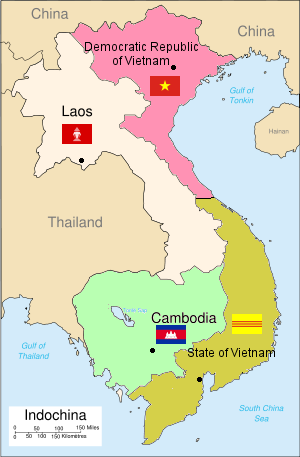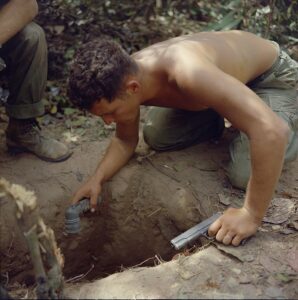In my previous essay, I discussed a few contemporary works of folk music, that, in my opinion, are natural successors to the epic poems of antiquity. I continue the “epic poems” theme in this essay, but shift to the epic works of conflict; focusing on the rock and roll genre, as influenced by the Vietnam War, which remains in my memory as a chaotic and tragic period of American foreign policy history.
However, discussions regarding ending the war in Afghanistan, America’s longest war, are again underway; and so, it may be a good time to revisit how we ended what will, consequently, become “America’s Second Longest War”.
Returning to the original theme, songs that were inspired by past conflicts include “Yankee Doodle” (mid-1700s); “When Johnny Comes Marching Home” (1863); “Over There” (1917); “We’ll Meet Again” (1939); and “Boogie Woogie Bugle Boy” (1941).
In advance of reviewing the songbook of the Vietnam War, I provide, in the following, an overview of how the United States became entangled in Vietnam.
However, my goal is to present the War at the “boots on the ground” level; i.e., from the perspective of the “grunts and jarheads”. Note that these are not insulting terms. In Vietnam, ‘grunts’ were U.S. Army and Marine Corps infantrymen, or foot soldiers. ‘Jarheads’, on the other hand, are USMC personnel of any rank; and the term is an homage to the high and tight haircuts worn by Marines.
I don’t feel that you can appreciate the music without understanding the war.
Vietnam: The War formerly known as “America’s Longest” (1954 to 1975)
The war in Vietnam was extraordinarily unpopular with Americans. There was no “Pearl Harbor” or “Nine-Eleven” at its beginning; and most Americans probably had only limited knowledge of that part of Asia. Vietnam was the first truly televised war. Camera crews were on-site almost continually; and journalists often recorded their coverage right in the field. Thus, Americans had a very realistic view of the devastation and violence of the War.
The Threat of Falling Dominoes:

After armed forces led by communist leader, Ho Chi Minh, defeated French colonial forces in 1954, and ended nearly 75 years of French colonial rule, world and regional leaders passed the Geneva Accords, which divided Vietnam into the communist North and a more democratic South.
President Eisenhower warned that the situation in Vietnam was like, “a falling domino, whose loss would lead to rapid and widespread communist victories in neighboring countries.”
Ho Chi Minh then sought to unify the two Vietnams under his communist regime; and precipitated the conflict that placed North Vietnam, with its Viet Cong allies in the South, against South Vietnam and its principal ally, the United States.
The United States provided funding, armaments, and training to South Vietnam’s government and its military. Unfortunately, tensions rapidly escalated into widespread armed conflict, and President Kennedy expanded our military aid and committed to deploy soldiers to the region.
In his 1961 inaugural address, Kennedy had stated his belief that “U.S. security may be lost piece to piece, country by country, as the result of the domino effect”.
After Kennedy’s death in 1963, his successor, Lyndon Baines Johnson, continued down the same path, and further increased troop deployments.
“Domino” was then used by successive administrations to justify continued escalation of our involvement in Vietnam. Note that Congress never declared war, and never formally gave the President the authority to escalate our presence in Vietnam until early 1964; and only after the “Gulf of Tonkin Incident”, during which the North Vietnamese fired on two American ships in international waters.
At the same time, the Soviet Union and China were pouring weapons and supplies into the North; and providing combat troops for North Vietnam’s campaign against the South.
By 1969, more than 500,000 U.S. military personnel were stationed in Vietnam, and the bulging costs and casualties of the war finally proved too much for Americans to endure, and a poorly-conceived peace agreement was negotiated by the Nixon Administration’s national security advisor, Henry Kissinger, in 1972.
The Paris Peace Accords resulted in the withdrawal of all U.S. and allied forces, the release of Americans who were prisoners of war, and a very loose cease fire, which was almost immediately violated.
The end of the Vietnam War actually occurred on April 30, 1975, after the Saigon government surrendered to the North. Over the next 12 months, North and South were formally united under the control of North Vietnam’s communist government, becoming the Socialist Republic of Vietnam.
Vietnam has estimated that nearly 2 million civilians (i.e., both North and South) perished; and over a million North Vietnamese and Viet Cong fighters were killed. The U.S. military estimates that nearly 250,000 South Vietnamese soldiers died in the war.
The American Soldier in Vietnam:
Between 1964 and 1973, the U.S. military drafted 2.2 million American men from an eligible pool of about 27 million. Historian, Christian Appy, observes, in “Working-Class War”, that the average U.S. soldier was 19-years-old, and from a poor or working-class family, and had not attended college.
A large portion of U.S. troops were African-American men from the inner cities, boys from farming communities, and the sons of immigrants from factory towns. Many of these men enlisted or were drafted right out of high school.
These young soldiers found themselves in a land of intense heat and humidity, flooded fields, and dense jungles. It could rain nonstop for days at a time during monsoon season.
They were not welcomed by the local farmers and villagers, but viewed with distrust or hostility. To the Vietnamese, this was the “Resistance War Against America”.
The fighting conditions in Vietnam were “dreadful” and strained our military tacticians. Unlike past conflicts, Vietnam combat was not “conventional”; rather, it was guerrilla warfare; and the jungles made this form of attack very effective. Tactics included ambushes, sabotage, “hit-and-run” raids on our supply operations, and booby traps. Some civilians, including women and children, actively assisted the Viet Cong guerillas.

An additional problem was the extensive underground system of tunnels, which was used by the Viet Cong; and “tunnel rat” became an unofficial specialty for those who cleared and destroyed enemy tunnel complexes.
The final Vietnam War tally was 58,148 killed and 75,000 severely disabled. Of those killed, nearly two-thirds were younger than 21-years-old; and the Marines accounted for a third of all American casualties.
Many of our servicemen were exposed to the chemical defoliant, Agent Orange; and hundreds of thousands of Vietnam veterans have died from their exposure to dioxin, the deadly toxin in Agent Orange. Dioxin can cause multiple cancers, peripheral neuropathy, and has also been linked to an elevated risk for Parkinson’s Disease.
Epics of the Vietnam War Era:
“Stars and Stripes”, the daily independent news source for the military, named Vietnam “the first rock and roll war”. It was the Sixties, these were young men, and the songbook was immense.
In the next essay, I will review a series of songs from that era that provide some insight into how many Americans responded to the War and expressed their opposition.
Editor’s Note: This is the opinion of Thomas D. Gotowka.
Author’s Notes: On April 25, 2021 the New York Times reported 571,753 COVID deaths in the United States; nearly a ten-fold increase over our Vietnam War combat deaths. I recall how intense our response was to Vietnam casualty reports, which were eventually updated almost daily on the then still-trusted evening news. I don’t believe that we’ve ever mourned COVID deaths with that same passion.
Anti-Vietnam War protests increased remarkably in the United States through the 1960s, and the draft became the focus of organized resistance. Despite our technological advantages, larger forces, and better weapons, the Viet Cong were able to hold us off and prevent the United States from achieving any sort of victory in Vietnam from winning.
The public was never really in support of the war.
Tragically, our returning soldiers were often treated with contempt. These servicemen usually did a one-year tour of duty. Men came back from Vietnam by themselves rather than with their units; and, as one soldier shipped out, another returned home.
I served during the Vietnam War era, but the entirety of my active duty was at the Naval Hospital at NAS Pax River, MD. My patients were primarily Naval Aviators, and their ground or flight deck support, returning from or going to the war zone.
At the very least, in 1982, the Vietnam Veterans Memorial was dedicated in Washington, D.C., inscribed with the names of 57,939 members of U.S. armed forces, who had died or were missing as a result of the war.
My close childhood friend was killed in action, and his name, Gary John Shea, is engraved on Panel 61E Line 2 of the Memorial. I have seen the engraving.

Tom Gotowka
About the author: Tom Gotowka’s entire adult career has been in healthcare. He’ will sit on the Navy side at the Army/Navy football game. He always sit on the crimson side at any Harvard/Yale contest. He enjoys reading historic speeches and considers himself a scholar of the period from FDR through JFK.
A child of AM Radio, he probably knows the lyrics of every rock and roll or folk song published since 1960. He hopes these experiences give readers a sense of what he believes “qualify” him to write this column.
You made very interesting comparison between Vietnam and COVID deaths. There will be many more COVID deaths if people don’t get the vaccine. Right now we’re not on pace to achieve here immunity. I am OK with those personal decisions once my children get vaccinated. Until then, each person is like a domino, waiting to fall, and infect my children, who don’t have the option to choose to get or not get the vaccine.
Too bad you left out the song ‘Ohio’ about the Vietnam War and the 1970 Kent State massacre.